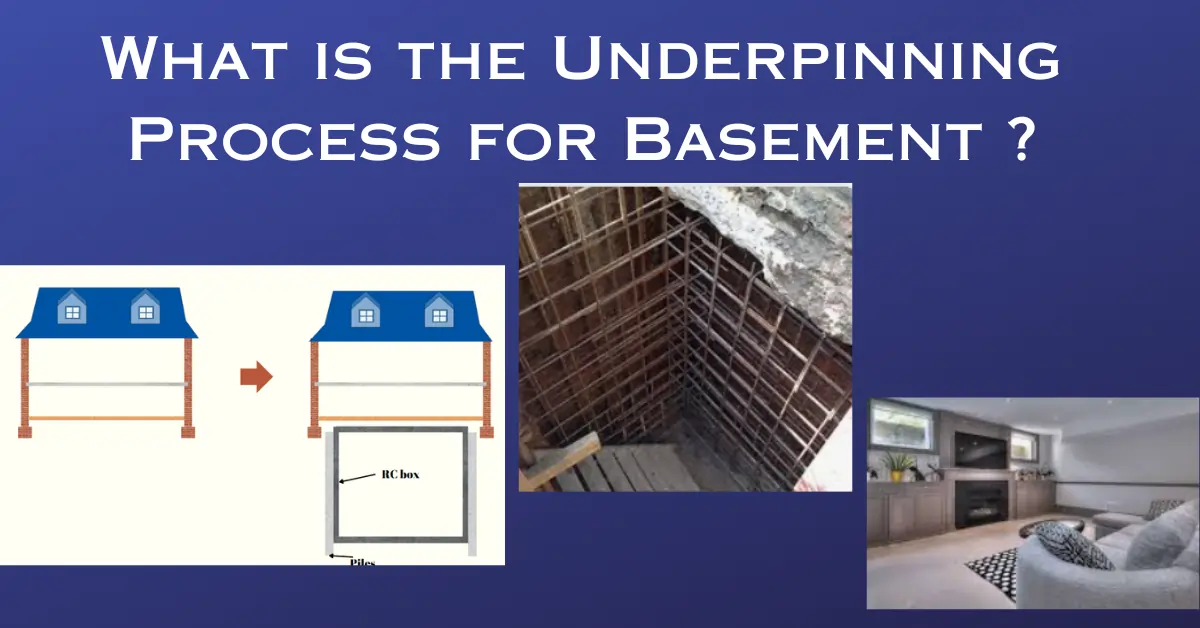Underpinning is a technique of strengthening the foundation of a structure by adding more support below it. It is often used to repair damaged or weak foundations, increase the load-bearing capacity of the structure, or lower the basement floor level to create more space.
There are different methods of underpinning, depending on the type and condition of the foundation, the soil characteristics, the design and budget of the project, and the local regulations and codes. Basement underpinning is performed to increase head height or add new basements to an existing building. The method is chosen if the benching the basement is not considered a suitable option. In this blog post, we will discuss three common methods of underpinning for basements: mass concrete, reinforced concrete, and pile underpinning.
Types of Basements
There are two types of basement underpinning with regard to the type and level of construction. The choice of the method of underpinning a basement depends on the cost, type of construction, complexity of work, soil, and environmental conditions. That is because some methods of underpinning are good for some types of soil, basement structures, and environmental conditions and not for others.
Extension of height of cellars
This type of retrofit construction is the simplest. The existing cellar or vault’s head height is typically increased by underpinning the existing walls in order to extend the existing foundations downward.
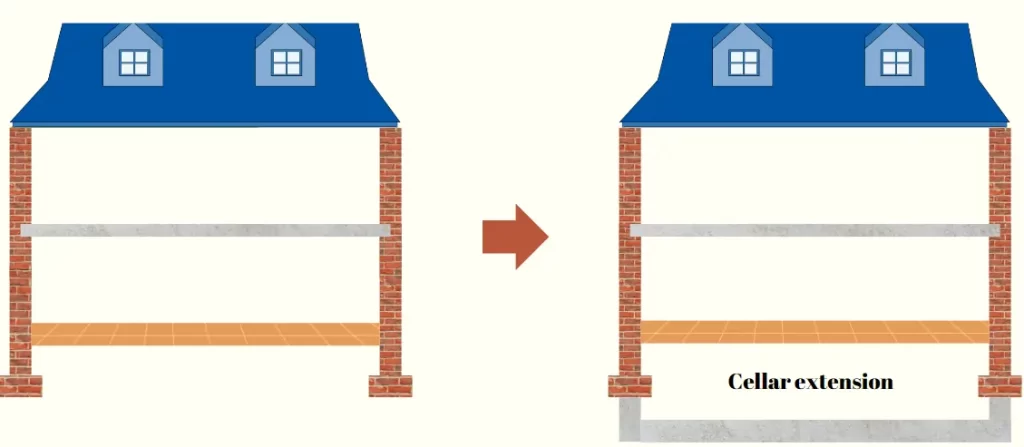
Addition of a level of basement or multi-levels of basements
This involves adding a new basement level or multiple levels of basements below the lowest internal floor or a garden.
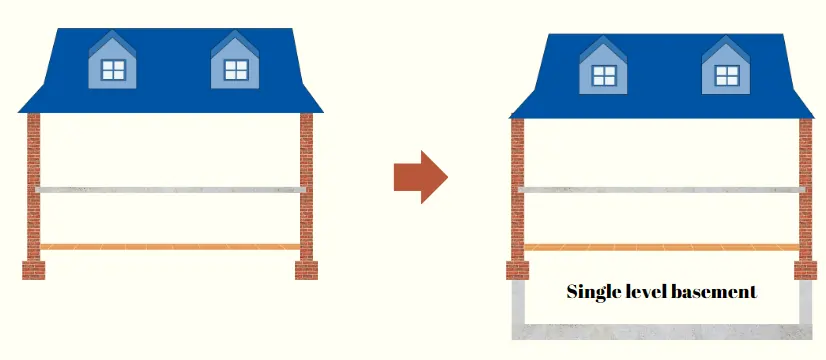
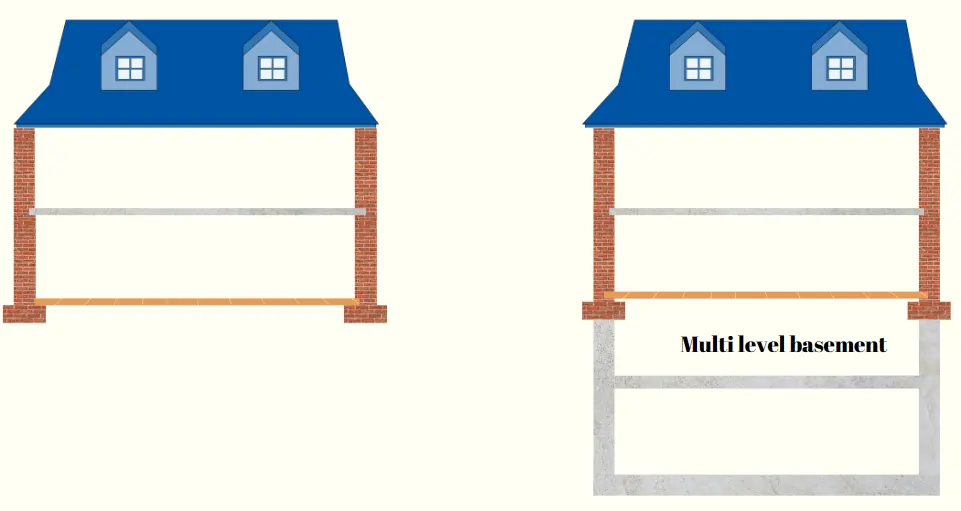
Structural requirement of basement underpinning
The traditional underpinning method involves lowering the existing foundation by using underpins that are constructed of mass concrete. These underpins only transfer vertical loads to more stable ground.
However, in the basement underpinning the structural requirements are:
- To transfer the vertical load on the existing foundation to the new lower foundation level
- Support the horizontal loads from the ground, hydrostatic pressure from the groundwater table, and any surcharge loads that exist on the outside walls of the basement.
Hence, when the depth of the basement is large, reinforced concrete and piling methods meet both criteria. Since the ground forces are powerful and a real danger the basement walls and temporary supports must be designed to resist the forces during all construction stages. If the structural capacity of the basement wall or temporary structure is lacking at any point during the construction, there is a risk of the collapse of the building. The movement of the basement walls is a real danger to the building.
The horizontal forces should be designed by a professional in all stages of the permanent construction as well as temporary construction such as shoring or timbering. The final completed design basement as well as all temporary structures must be able to resist the ground forces at all stages of the construction.
Mass Concrete Underpinning
Mass concrete underpinning is the oldest and simplest method of underpinning. It involves digging a series of pits or trenches under the existing foundation and filling them with concrete to form new footings. The new footings are connected to the old ones by concrete needles or beams. The process is repeated in a staggered pattern until the entire foundation is underpinned.

The advantages of mass concrete underpinning are:
- It is relatively cheap and easy to execute.
- It does not require heavy machinery or specialized equipment.
- It can be done in stages without disturbing the occupants of the structure.
The disadvantages of mass concrete underpinning are:
- It is not suitable for deep or unstable soils.
- It can cause differential settlement or cracking of the structure due to uneven loading or curing of the concrete.
- It can be time-consuming and disruptive to the surrounding environment.
Reinforced Concrete Underpinning
Reinforced concrete underpinning incorporates structural elements to resist the horizontal loads from the ground, hydrostatic water pressure, and surcharge loads on the outside boundary of the basement wall. Is a more advanced and durable method of underpinning. It entails digging parts of the old foundation systematically into sections of pins and pouring concrete into reinforced steel cages that are placed in the newly excavated to form the basement structure. The steel reinforcement imparts the basement the capacity to resist horizontal forces. There are two ways to construct reinforced concrete basement underpinning.
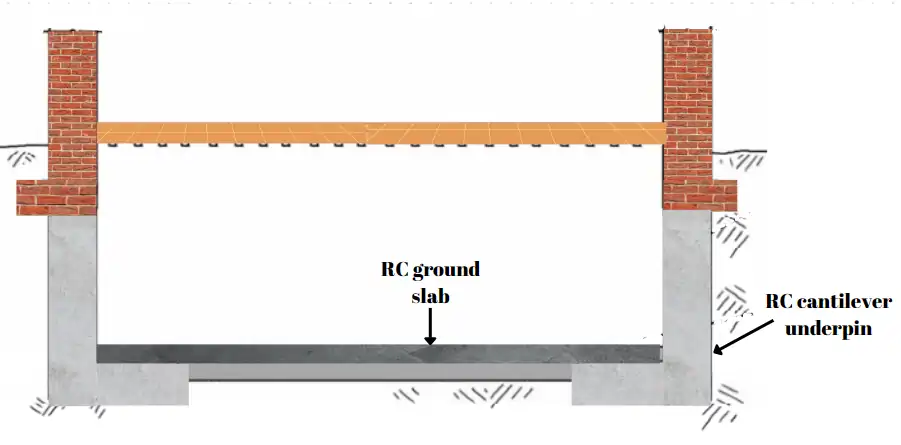
- a vertical cantilever with a turning moment acting around the end of the base, meaning the lower section of the underpin is held firmly in place and the vertical wall is strong enough to prevent soil outside the basement or any other external horizontal forces from pushing the underpin foundation wall out of vertical, or as
- A vertical beam that is held in place at both the bottom and top by the RC basement roof slab or another type of structural system.
The advantages of reinforced concrete underpinning are:
- It is suitable for deep or variable soils.
- It can resist lateral forces and bending moments due to soil movements or seismic activity.
- It can provide a smooth and level basement floor.
- Suitable for deeper depths since the steel reinforcement reduces the size of the underpinning.
The disadvantages of reinforced concrete underpinning are:
- It is more expensive and complex than mass concrete underpinning.
- It requires skilled labor and engineering supervision.
- It can cause damage to the existing foundation or utilities if not done properly.
Pile Underpinning
Pile underpinning emerges as a contemporary and highly efficient technique for foundation reinforcement. This method entails the insertion of piles into the ground beneath the existing foundation, subsequently linking them to the structure via concrete caps or beams. These piles facilitate the transfer of the structure’s load to a deeper and more stable layer of soil, effectively bypassing the weaker or more compressible soil present near the surface.

In the realm of basement construction, two principal types of piles take center stage:
Reinforced Concrete (RC) Bored Piles: These piles are fashioned by first creating a bored hole in the ground, followed by filling it with concrete and reinforcement.
Steel Sheet Piles: Constructed using slender interlocking steel sheets driven into the ground,
Piles are used in
-Establishing structural basement walls, though generally not feasible below the existing building’s walls.
-Bearing vertical loads in both temporary and permanent scenarios (exclusive to RC piles).
-Securing the basement ground slab against uplift from hydrostatic pressure or clay heave (applicable to RC piles).
For piled retaining walls, whether employing reinforced concrete bored piles or steel sheet piles, an inner RC wall or box is indispensable in the permanent condition. This element offers horizontal strength and serves as a waterproofing measure.
The machinery employed for piling necessitates a certain amount of space around the drilling head. Consequently, there inevitably arises a gap between the pile’s edge and the inner facet of the preexisting wall. In instances of terraced properties, this translates to a reduction in the usable basement area when compared to the area directly above it.
The dimensions of the piles can be influenced by the size of the piling rig utilized, which is inherently determined by factors like site dimensions, available vertical clearance, and accessibility. In broad strokes, opting for larger piling rigs facilitates quicker and more cost-effective piling procedures.
The advantages of pile underpinning are:
- It can achieve high load-bearing capacity and stability.
- It can be done in any soil condition or depth.
- It can be done quickly and with minimal disturbance to the structure or environment.
The disadvantages of pile underpinning are:
- It is the most expensive and technical method of underpinning.
- It requires specialized equipment and expertise.
- It can cause vibration or noise during pile installation.
Step-by-step procedure of basement underpinning
The general method of underpinning is similar. It is the core principle of underpinning smaller sections that can not affect the integrity of the structure one after another until the whole structure is underpinned.
The steps of the construction of the reinforced concrete basement underpinning can be described as follows:-
Step 1: Excavation
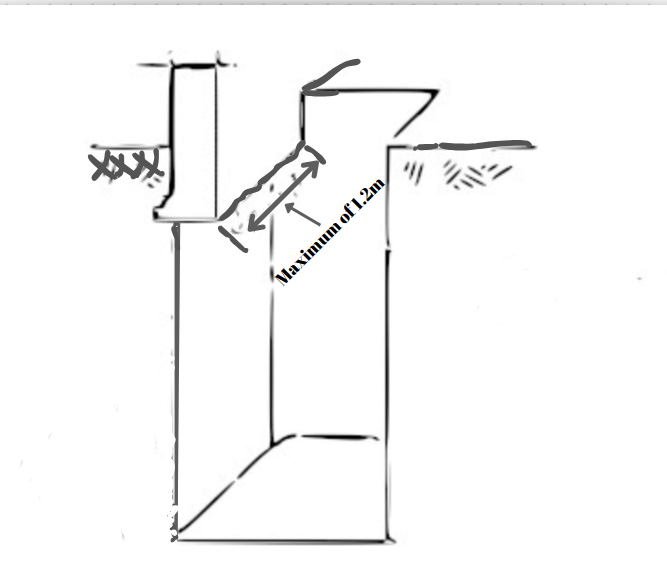
Excavate the pit according to design with adequate support of shoring and props. To prevent falls into the ditch provide protection at edges. The excavation wall should be checked for stability or provided with temporary works like timbering. The load from the existing structure will span the pit without problem because the excavation is 1- 1.2m.
Step 2: Reinforcement preparation
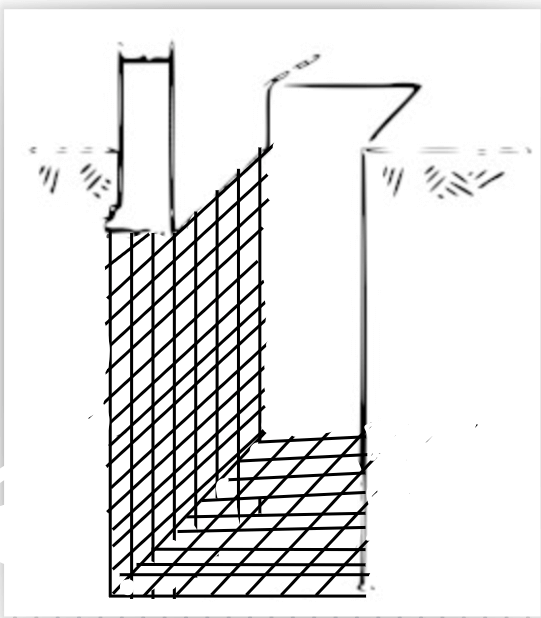
Reinforcement is fixed into position.
Step 3: Placing of concrete

Concrete is placed starting from the toe. After the concrete of the toes is cured the concrete is placed on the wall. To hold the concrete a wood formwork can be used. There is a gap between the top of the concrete and the underside of the existing foundation of around 75mm.
Step 4. Dry packing
After about 24 hours of concreting, fill the 75mm gap that has been left above the new underpin with cement and sand mix(dry pack). A drypack is suitable because it is easy to handle and limits the settlement of the existing wall because it has low shrinkage property.
N.B. Until the ground slab and perhaps other permanent works are built, the completed foundation must be supported horizontally, either by horizontal propping or by backfilling the excavation.
Comparison Table
The following table summarizes some key features and differences among the three methods of underpinning for basement:
| Method | Cost | Time | Soil Condition | Depth | Load Capacity | Disruption |
| Mass Concrete | Low | Long | Shallow/Stable | Up to 3 m | Low/Medium | High |
| Reinforced Concrete | Medium | Medium | Deep/Variable | Up to 6 m | Medium/High | Medium |
| Pile | High | Short | Any | Any | High | Low |
Conclusion
Underpinning is a valuable technique of enhancing the foundation in retrofit and repair works. The technique enhancing of a structure by adding more support below it. One of the need of underpinning construction in the retrofit business is new basement construction. The addition of a new basement can be done with various methods and the choice is made by studying the alternative that is best suited to the particular conditions of the planned works.

